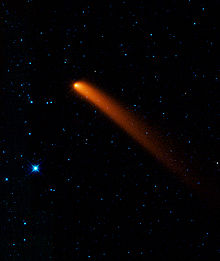- Comet Siding Spring
-
C/2007 Q3 (Siding Spring) 
WISE infrared image of C/2007 Q3 January 10, 2010[1]Discovery Discovered by: Donna Burton
Siding Spring Survey
0.5-m Schmidt (E12)[2][3]Discovery date: 2007 August 25 Orbital characteristics A Epoch: 2455014.5
(2009-Jul-02)Aphelion distance: ~15,000 AU[4] (Q) Perihelion distance: 2.25166 AU (q) Semi-major axis: ~7,500 AU[4] (a) Eccentricity: 1.0002077[5] Orbital period: ~650,000 yr[4] Inclination: 65.6504° Last perihelion: October 7, 2009 Next perihelion: unknown Comet Siding Spring, official designation C/2007 Q3, is a comet that was discovered by Donna Burton in 2007 at Siding Spring Observatory in New South Wales, Australia.[6] Siding Spring came within 1.2 astronomical units of Earth and 2.25 AU of the Sun on October 7, 2009.[1] The comet was visible with binoculars until January 2010.[6]
Images of the comet taken in March 2010, showed that the nucleus may have fragmented.[7]
The comet has an observation arc of 1,327 days and is still been observed as of April 2011.[5] The orbit of a long-period comet is properly obtained when the osculating orbit is computed at an epoch after leaving the planetary region and is calculated with respect to the center of mass of the solar system. Using JPL Horizons, the barycentric orbital elements for epoch 2030-Jan-01 generate a semi-major axis of 7,500 AU, an apoapsis distance of 15,000 AU, and a period of approximately 650,000 years.[4]
Before entering the planetary region (epoch 1950), C/2007 Q3 had a calculated barycentric orbital period of ~6.4 million years with an apoapsis (aphelion) distance of about 69,000 AU (1.09 light-years).[4] The comet was probably in the outer Oort cloud for millions or billions of years with a loosely bound chaotic orbit until it was perturbed inward.[8]
References
- ^ a b "Visitor from Deep Space". NASA. February 17, 2010. Retrieved on February 19, 2010.
- ^ "IAUC 8865: P/2007 Q2; C/2007 Q3". IAU Central Bureau for Astronomical Telegrams. 2007 August 30. http://www.cbat.eps.harvard.edu/iauc/08800/08865.html#Item2. Retrieved 2011-04-20.
- ^ "MPEC 2007-Q44 : COMET C/2007 Q3 (SIDING SPRING)". IAU Minor Planet Center. 2007 August 30. http://www.minorplanetcenter.org/mpec/K07/K07Q44.html. Retrieved 2011-04-20.
- ^ a b c d e Horizons output. "Barycentric Osculating Orbital Elements for Comet C/2007 Q3 (Siding Spring)". http://ssd.jpl.nasa.gov/horizons.cgi?find_body=1&body_group=sb&sstr=C/2007+Q3. Retrieved 2011-04-20. (Solution using the Solar System Barycenter and barycentric coordinates. Select Ephemeris Type:Elements and Center:@0)
- ^ a b "JPL Small-Body Database Browser: C/2007 Q3 (Siding Spring)". Jet Propulsion Laboratory. 2011-04-13 last obs. http://ssd.jpl.nasa.gov/sbdb.cgi?sstr=C/2007+Q3. Retrieved 2011-03-07.
- ^ a b Evans, Kate (February 19, 2010). "'Australian' comet captured by NASA". Australian Broadcasting Corporation. Retrieved on February 19, 2010.
- ^ Baldwin, Emily (March 17, 2010). "Is Comet Siding Spring splitting up?". Astronomy Now. Retrieved on March 19, 2010.
- ^ "Multimedia Gallery: comet Siding Spring streaking across the sky". WISE. Feb. 17, 2010. http://wise.ssl.berkeley.edu/gallery_comet_v.html. Retrieved 2011-04-20.
External links
- Orbital simulation from JPL (Java) / Horizons Ephemeris
- C/2007 Q3 ( Siding Spring ) - Seiichi Yoshida @ aerith.net (with pictures taken by different astronomers around the world)
- Curious coma-tail of C/2007 Q3 (Siding-Spring) (Remanzacco Observatory March 9, 2009)
- Spliting of C/2007 Q3 (Siding spring) nucleus (Leonid Elenin April 2nd, 2010)
Categories:- Comets
Wikimedia Foundation. 2010.
